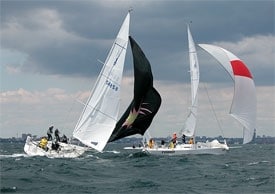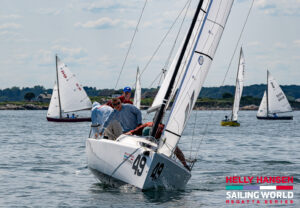
TorontoNOOD1
“We’re the amateurs,” said the skipper of Battlewagon, all smiles after picking up his trophy. “We’re your weekend warriors.” The winner of the J/35 class at the Rogers Wireless/Sailing World NOOD at Toronto and his crew were enjoying the post-race celebration with good reason. In one season, Roger Walker, 44, had leap-frogged from a mid-fleet finish at the 2003 J/35 North Americans to a class victory ahead of the top four boats at the NAs–Jake, Das Blau Max, Falcon, and the champ, Buckaroo Banzai. A steady effort to upgrade the program had suddenly come into focus for Team Battlewagon. Buckaroo, skippered by David Ogden backed up by tactician Terry McLaughlin, started early in second race but then kept closing the gap on Battlewagon and Ed Bayer’s Falcon during the nine-race, no throwout series. Three points separated the boats at the start of the last race. “The entire fleet went to blades,” said Walker, “but the sea state was building and we wanted the extra power, so we hoisted our heavy No. 1. There was chaos on the line as the gun went off, but we leaped into a hole and immediately the advantage of the big sail was felt.” Buckaroo started in the second row, and when Ogden tacked for clear air, Walker, with sailmaker Geoff Moore calling tactics, covered him and went on to win by a quarter of a leg. “Sometimes I regret teaching these guys match-racing tactics,” McLaughlin said later. Moore sailed in his afterguard while winning the 2003 Canada’s Cup match race. In describing four seasons work on Team Battlewagon, Walker says, “We put in 300 man hours fairing the bottom after the first year, and last winter we attended North U.; then Geoff worked with us to choreograph the movement of each crew.” During the same time span, Battlewagon’s competition steadily raised the bar, as Walker and long-time rival Allan Stokes helped build the Toronto area J/35 fleet into the biggest anywhere. The two sailors had grown tired of souping up their boats for PHRF. Starting with four in the fleet, they now have 12 to 14 J/35s regularly racing and hosted 27 at the J/35 NAs in 2003. Encouraging one-design racing in bigger boats is what the Sailing World NOOD series is all about, and by partnering with the Royal Canadian YC and National YC, the first Canadian NOOD was launched in a big way, bringing 22 classes and more than 200 boats to the starting line. Add to that three days of fair to great winds, plus the title sponsorship of Rogers Wireless–one of Canada’s leading wireless communications companies–and it was a successful event out of the box. While it takes a leap of faith to travel and enter any new event, for two-time Etchells world champs Glenn and Bruce Burton, of Grosse Point, Mich., the drive east was a no brainer. “This is the best place to sail in North America,” said Bruce, standing on the expansive lawn of the RCYC after steering Gone to second overall. “You get a typical Midwestern breeze here. It’s a big lake with lots of shifts–halfway between an inland lake and ocean sailing.” Burton also pointed out that while the Etchells fleet had only a dozen boats, the talent ran deep, including former Olympian Allan Leibel and past world champ Dirk Kneulman who bested the Burtons in the last race. Given the sheer size of the event, National YC joined RCYC as host, providing shoreside facilities (RCYC is on an island, a mile across Toronto’s Inner Harbour). National also hosted the first day’s party and, with RCYC and Ashbridges Bay YC, provided a race committee for one course. Some logistical issues had to be resolved, for example, centralizing protest hearings, and a number of scoring mistakes had to be corrected during the regatta. But most problems were mechanical and should easily be improved upon next year. RCYC member Chris Steer, chair of the Lake Ontario Racing Council, was a prime instigator of the event. “I wanted to see a rebirth of yacht racing here as the most important thing yacht clubs do,” he says. Steer’s Nelson/Marek 36 Maggie Kelly didn’t have a one-design class to race in, but he borrowed the C&C 99 Trumpeter and won his class with a pair of wins on the last day. “It took us a little while to get used to it,” he says, “and we were a little surprised and delighted to win.” Steer had hoped for a fleet of 250 but was satisfied with 208: “It was an excellent event–a real blast from the past. It’s what I remember from years ago when the RCYC lagoon was full of boats flying their battleflags.” One class which might have fielded even more than the 20 boats that raced is the Shark class, won by James Barkman’s Silver Phantom. This 1969 George Hinterhoeller design is indigenous and ubiquitous, with hundreds in western Lake Ontario. Competition is good and used boats are inexpensive?commonly sold for $7,500 to $12,000 (Canadian). The 24-footer has a small cabin, short rig, and as David Dawson, foredeckman on Silver Phantom says, “It’s a big dinghy with a keel on it.” Light enough, apparently, for Silver Phantom to take a knockdown in a big gust on the starting line, which got their last race off to a slow start. Whether or not it was really the 50-knot gust, Dawson said that setback combined with a shift on the last beat to give Silver Phantom a narrow win over John Brunt’s UNC. One month after the Tornoto NOOD, Battlewagon’s Walker, an executive at Oracle who builds sales teams, was still feeling good. There may be similarities between sales teams and racing crews, but normally the sales guys don’t have to make a weight limit first. “When we started out, the fleet used to call us ‘Cattlewagon,'” he says. “They would moo whenever we crossed them. So pop and chips were replaced by water and granola bars, and beer was restricted to one a piece for the ride home. Everybody lost 15 to 20 pounds each.” Although Walker refers to his crew as “the boys,” his wife Tama does the pit and Yngling sailor Felicity Clarke is often aboard helping with tactics. Walker credits the team’s crewwork, refined in practice sessions with Moore, for making “a big difference,” and says they simply don’t make many mistakes anymore. When his regular tactician couldn’t sail the NOOD and Moore volunteered to fill in, Walker deciding to try fitting the sailmaker in without upsetting the crew dynamics. “My hat is off to Geoff,” says Walker. “When we’ve had other pros, people have become more tentative. Geoff is good at working with the crew and not trying to be dominant. And he allowed me to focus completely on my driving.” Perhaps more important, Walker says he learned a lesson at last year’s J/35 NAs, when he changed sailmakers and bought a new inventory, but didn’t get his rig tuned right until the end of the regatta. “That was a big, dumb mistake,” he says. “Winning really comes from doing 20 or 30 little items that make a 1 or 2 percent difference–fixing the rudder bearings, doing the keel, absolute tuning of the mast, changing fittings so nothing breaks and so on.” What about having a champion sailor such as Moore calling tactics? “Maybe that’s 3 or 4 percent,” he allows. “I’m trying to get him to sail with us when we go to the North Americans next year.” Like the Rogers Wireless Sailing World NOOD, the NAs will be back on the Great Lakes next year–just in time for another dark horse to make a run for the money.









